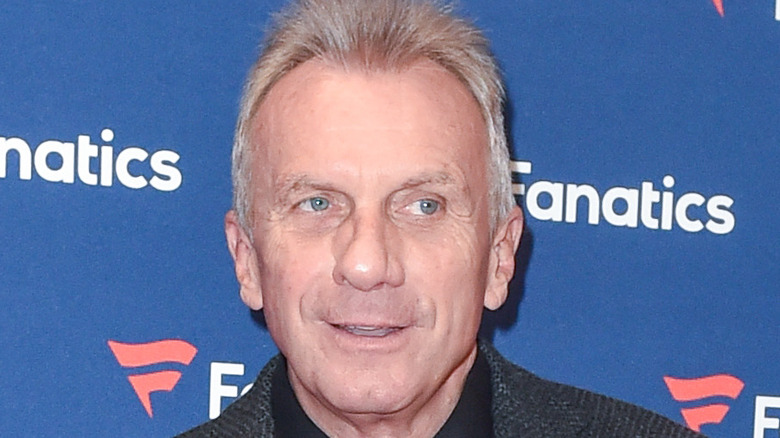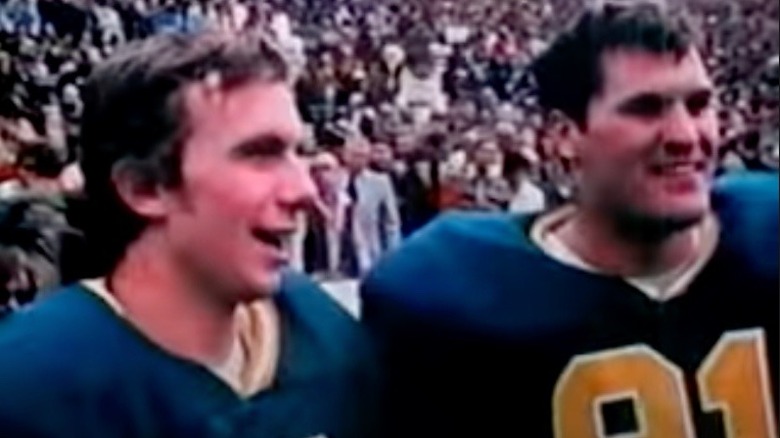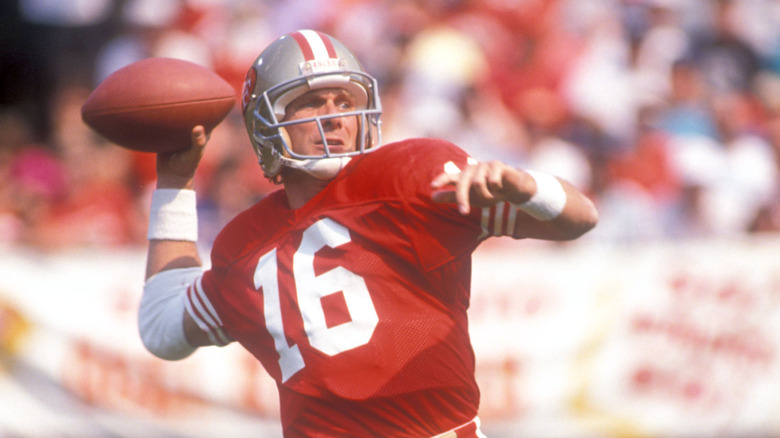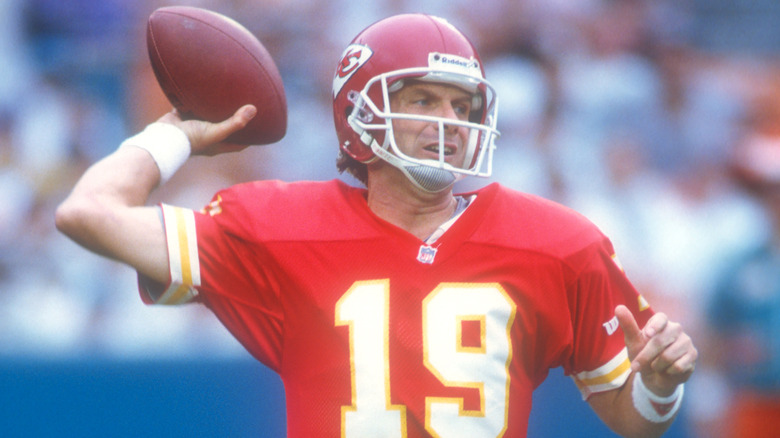The Untold Truth Of Joe Montana
There are certain NFL personalities whose names are inextricably linked to the Super Bowl, and Joe Montana is one of them. Born on June 11, 1956, in New Eagle, Pennsylvania, Montana grew up to become one of the many star quarterbacks to come out of the University of Notre Dame, and while he wasn't selected in the first round of the 1979 NFL Draft, that didn't stop him from becoming one of the greatest and most decorated signal-callers in NFL history.
When talking about Montana's NFL career, there are so many things you can mention, from his four Super Bowl wins with the San Francisco 49ers to "The Catch" — that game-winning touchdown pass to Dwight Clark that helped the Niners win the NFC Championship Game on January 10, 1982. All those accomplishments, plus his two MVP awards, eight Pro Bowl appearances, the many times he led the NFL in one statistical category or another, and his eventual Pro Football Hall of Fame induction in 2000 don't really need a deep dive. But what about the lesser-known details about Montana's time as an athlete, as well as his life outside of football? Join us as we take a look at some of those details.
His favorite sport growing up wasn't football
During his formative years in Monongahela, Pennsylvania, Joe Montana was a three-sport star who excelled in football, baseball, and basketball. But out of those three sports, it wasn't football that he was most interested in — the man who would later be known as Joe Cool was a basketball fan more than anything else. Speaking to Sports Illustrated in 1990, Montana recalled that he "could practice basketball all day," whereas football practice felt more like work to him. There was no doubt back then that basketball was Montana's favorite sport, and as a high school senior, he won a league championship at Ringgold High School, where his coach remembered a player who could "stand flat-footed and dunk with two hands."
After wrapping up an exemplary high school athletic career in 1974, Montana received several scholarship offers, including a basketball scholarship from North Carolina State. Had he accepted that offer, he would have been part of a team that was fresh off an NCAA championship and most notably featured high-flying would-be NBA superstar David Thompson. But as a Parade All-America selection at quarterback, he was, first and foremost, a highly recruited prospect in football, and after considering offers from dozens of schools, Montana committed to Notre Dame. This was mainly on account of the fact that his favorite football player (and fellow Pennsylvania native), Terry Hanratty, was a star QB for the Fighting Irish in the mid-to-late '60s.
A bumpy ride to first-string duty, but a whole lot of comeback wins in college
Joe Montana (pictured above at left) was oftentimes known as "The Comeback Kid," and his ability to snatch victory from the jaws of defeat first became evident during his time with the Notre Dame Fighting Irish. But his time at South Bend wasn't all come-from-behind victories and gridiron glory, as documented by Sports Illustrated. As a freshman, he was just one of multiple blue-chip recruits at quarterback, and since the Fighting Irish had the highest hopes for one Gary Forystek (you can check his Sports Reference page to see how he panned out), Montana was barely utilized in the freshman games.
Following some strong performances at spring practice, Montana moved up from the bottom of the depth chart to No. 2 as a sophomore, and he showed lots of promise, engineering a few memorable comebacks in the 1975 season. Unfortunately, a shoulder injury forced him to sit out the entirety of the 1976 campaign, and when he came back in 1977, he was behind future NFL player Rusty Lisch and the aforementioned Forystek as the Irish's No. 3 QB. He sat out the first two games of the 1977 season, but thanks to his play in a come-from-behind win against Purdue, Notre Dame coach Dan Devine finally promoted Montana to first-string duty.
Montana wrapped up his college football career with the now-iconic "Chicken Soup Game," where the quarterback, suffering from hypothermia, warmed up with some bouillon (which, technically, is not chicken soup), reentered the game with 7:37 remaining, and led Notre Dame from 22 points down to a nail-biting 35-34 win over the Houston Cougars at the 1979 Cotton Bowl. Talk about ending one's career with a bang.
He was never known for his arm strength
All too often, we see NFL teams get seduced by arm strength during the annual Scouting Combine. These teams often opt for the cannon arm over the guy with strong fundamentals and other things that don't show up on the stat sheet. And while it sometimes works in their favor, there are times when it doesn't. That's pretty much how you can summarize the run-up to the 1979 NFL Draft, where Joe Montana, despite his myriad on-field heroics for Notre Dame, was only considered an average pro prospect (via Sports Illustrated).
During one combine, Washington State's Jack Thompson — the eventual No. 3 overall pick — scored an 8 out of 9 in terms of arm strength, while Montana got a 6. His overall scouting report didn't help matters, as he was described as a player who "doesn't have great tools" and tends to pass to his primary receiver "even when he's in a crowd." That contributed to him falling to the third round, where the San Francisco 49ers selected him 82nd overall.
We all know what happened next — Montana became a superstar for the Niners, while Thompson, aka the "Throwin' Samoan," had an unremarkable NFL career (read: he was a bust). And it wasn't like Joe Cool developed into a rocket-armed passer in the pros; as former NFL executive Mark Dominik told The Buffalo News, Montana made up for his lack of arm strength by being "exceptional in terms of just the timing and the anticipation of when things are going to come open in the box and be able to deliver the ball."
His time with the Chiefs: Strong play, but no additional Super Bowl wins
It isn't uncommon for great quarterbacks mainly associated with one team to finish their careers elsewhere. Johnny Unitas played 17 seasons for the Baltimore Colts before ending his career in 1973 with the then-San Diego Chargers. Speaking of the Chargers, Philip Rivers spent 16 years with that franchise, then played one final season with the Indianapolis Colts in 2020. And how can we forget Tom Brady, a New England Patriot from 2000 to 2019 who retired after two seasons with the Tampa Bay Buccaneers — and another Vince Lombardi Trophy in his case.
That brings us to Joe Montana, who was supplanted by another would-be Hall of Fame quarterback, Steve Young, while he sat out all of the 1991 season and most of 1992 due to an elbow injury. With Young unwilling to return to second-string duties (via The Pittsburgh Press), the aging Montana asked for a trade and got it — he was sent to the Kansas City Chiefs ahead of the 1993 season. To further ensure a smooth adjustment for Montana, the Chiefs also hired former 49ers quarterbacks coach Paul Hackett as their new offensive coordinator and adapted the split-back passing offense designed by Montana and former San Francisco head coach Bill Walsh.
While Montana put up superb numbers for a man his age and won 17 of his 25 starts, he wasn't able to lead Kansas City to the Super Bowl. (To be fair, no QB did ... until a certain Patrick Mahomes came along in the late 2010s.)
He's long been involved in the video game industry
When it comes to football video games, there is one man and one man only whose name comes to mind for most gamers, and that's the late coaching legend John Madden, whose namesake "Madden NFL" titles have dominated the market for years. But well before Electronic Arts became the exclusive developer of 11-on-11 NFL video games, Joe Montana had his own "Joe Montana Football" title for the Sega Genesis in the early 1990s. That, however, was far from his last foray in the world of gaming ... or football-related software in general.
In April 2013, Montana, along with CrowdMob CEO Damon Grow, announced an iOS app called "iMFL." According to TechCrunch, it's an app that combines elements of fantasy football with social features, allowing players to bet points on the outcomes of plays as NFL games take place in real-time. Four years later, Montana and Grow, now co-founders of Superstar Games, announced "Montana 17," a virtual reality game for the Google Daydream and Samsung Gear VR that, thanks to its NFL Players Association license, came with a number of real-life players, including Montana himself (via GeekWire). Unlike the "Madden" series, "Montana 17" features 7-on-7 gameplay and only allows players to control the quarterback.





